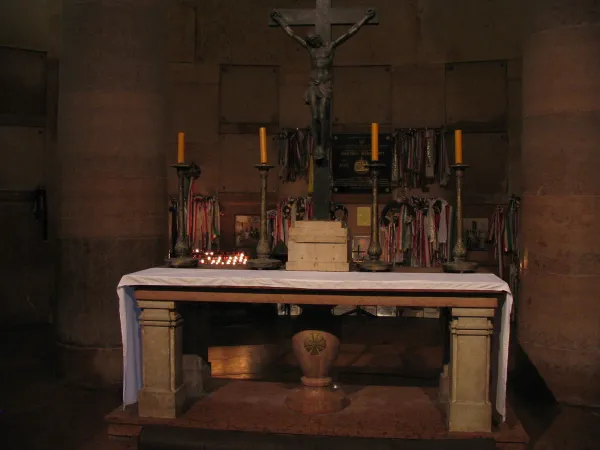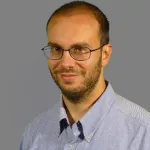
In his trip to Budapest, there were two moments when Pope Francis touched on the history of Hungary's recent saints. The first was in his address to the authorities, and the second was when he met with priests, seminarians, religious men, and women in St. Istvan's (St. Stephen's) Cathedral.
Speaking to the authorities, Pope Francis characterized Budapest as a "city of saints," recalling several Hungarian confessors of the faith, starting with King Stephen, who made Hungary Christian, passing through the entire family of the holy King, and ending with the Venerable Cardinal Jozef Mindszenty. President Novak also mentioned Mindszenty's name in her speech.
He then received an afternoon address of greeting from Jószef Brenner, an 88-year-old priest and brother of Jànos, who was martyred in 1957 when he was only 26 years old, and beatified in 2018
But Pope Francis' visit also touches, directly or indirectly, on the lives of other saints of Hungary, with stories to be discovered.
Cardinal Mindszenty
Only a miracle is awaited for Cardinal Mindszenty's beatification. Persecuted by the first communist government, He had been arrested as a priest by Bela Kun's communists back in 1919. He was arrested again by the new Soviet rulers, spending between 1949 and 1954 in prison.
Cardinal Mindszenty was then sent under house arrest and freed by the National Guard during the 1956 Revolution.
When the Soviets re-established the old regime, he took refuge in the U.S. Embassy in Budapest and could not attend the 1958 conclaves of 1963. In 1971, Cardinal Mindszenty was finally able to leave the U.S. embassy, and he went to Rome and then settled in Vienna. Although in his eighties, he began to travel the world to comfort Hungarian communities.
Although his story is one of martyrdom; eventually, his cause for beatification began as a confessor of the faith because he did not die as a martyr. Gergely Kovacs, the postulator of the Cardinal's cause for beatification, points out that "the story of his life shows us that he is a white martyr because he was martyred, although not killed. We have done interesting research regarding his life. In the last years of his imprisonment, he suffered from two serious stomach and lung diseases. These diseases, after his release, returned after four or five years."
Therefore, one might have thought that his cause was defined as martyrdom proper alumnus, or rather because of suffering, a formula already used for the beautification of Theophilus Matulionis in Lithuania and Greek Catholic Bishop Iuliu Hossu in Romania.
However, "the cause began as a confessor of the faith and must end as a confessor of the faith," Kovacs explains. The postulator also points out that there are prayer groups for Cardinal Mindszenty's beatification, even in Nigeria. An estimated 1.5 million prayers are elevated daily to propitiate the beatification. However, "there have been cases, but they are not miraculous. There was one case we had pinned much hope on, but unfortunately, in the year this miracle happened in Hungary, medicine was not so advanced that we could define whether it was a miraculous healing or not."
János Benner
Father Benner is already blessed. He was a priest in Szombathely, and the communist regime believed him to be an opponent because of his pastoral work. The bishop offered him a transfer for security reasons, but he replied that he fully trusted God.
"This is," says Kovacs, "a stunning example. He was young and had been asked to go and bring the sacraments to a sick man, and he went with the Eucharist. During the trip, more than ten policemen brutally killed him with 32 stab wounds, and he was found dead still holding the shrine with the Eucharist."
It was clear that the murder was deliberate. He was, Kovacs explains, "an excellent priest, respected by the youth, and in those years after the 1956 revolution, the Communist Party wanted to strengthen its power over the Catholic Church. The Communist Party gave the command to stop him or warn him, but the policemen went further."
The story of Blessed Batthiany and the sanctity of his wife
Then there is a story that the Pope will cross paths with the cause of the beatification of Maria Teresa Coreth, the wife of Blessed Batthiány-Stratman, who was beatified in 2003. The institute for the blind that Pope Francis visited on the morning of April 29 is named after the blessed.
László Antal János Lajos Batthyány-Strattmann was known as "the doctor of the poor." He was an aristocrat, a prince, who lived between 1870 and 1931, and who chose the civil profession instead of enjoying the privileges of his aristocratic status.
The sixth of six children, he soon found himself without a father, who abandoned the family, and without a mother, Countess Ludovika Batthyány, who died when the blessed was 12. He had a tumultuous part of life; he studied at the University of Vienna in several courses, including chemistry, philosophy, and music history. He had an illegitimate daughter whom he cared for until the end, and only in 1896 discovered his vocation to study medicine.
In the four years leading up to his graduation, he met Countess Maria Theresia Coreth zu Coredo und Starkenberg and married her in 1898. They had twelve children. Blessed László never stopped studying and became first a surgeon and then an ophthalmologist. He opened Hungary's first rural hospital in Kittsee.
His wife was also in the odor of sainthood, and Gergely Kovacs points out that "there is great devotion to her," and indeed, some consider her "even holier" than her husband. However, when the cause of beatification for Batthyány-Strattman opened, it was preferred not to open another one for his wife as well, for practical reasons. It was not yet the time for canonizations of married couples, which later became more frequent.
Franciscan martyrs
Then there is the cause of the "Franciscan martyrs," that is, of Bernát Károly and companions, all Franciscans, all of whom were killed in hatred of the faith in communist times.
Father Károly had even been on a mission to China, returned to Hungary in 1938, and then organized a hospital at the end of World War II. In 1945 he protested the humiliating treatment of political prisoners and was arrested for it. Then he was arrested twice in 1949, first for "anti-democratic preaching" and then for "anti-democratic conspiracy against the People's Republic." For this, he was sentenced to 15 years in jail in 1950 and was tortured there. According to testimonies, he continued to confess and help them until he died from the suffering.
Father Rafael Kriszten distinguished himself during World War II, saving many persecuted people. In 1950, deportations of religious began. But when the police truck stopped in front of the convent, the crowd protested. The protests only brutally ended in the night, and Father Rafael and three other Franciscan fathers were beaten and deported. Father Rafael was sentenced on May 26, 1951, to life in prison for conspiracy, and he also died in 1952 due to the mistreatment.
Krizosztom Körösztös, on the other hand, was from the convent in Novi Sad, Serbia, which belonged to the Hungarian province, and remained there even though he knew he was at risk. On October 23, 1944, religious and other inmates were taken by Serbian troops, and on October 28, they were killed.
Another martyr from the Franciscan convent in Novi Sad was Father Kristóf Kovács, who asked to be transferred to Vojvodina in 1944 because he wanted to die a martyr for Christ. He, too, was arrested and deported on October 26, 1944. He continued to comfort his comrades during their imprisonment; after the marches, he confessed them during the night, often administering the sacrament of penance to people who had not confessed in decades. Thus, he was separated from his comrades during a march and shot.
Father Szaléz Kiss was the master of clerics (spiritual director of seminarians) at the Franciscan monastery in Gyöngyös from 1944, and the novices lived through the Russian occupation under his supervision. To unite the city's youth, he organized the Christian Democratic Youth Cooperative in 1945, which the Communists did not approve of because it weakened their organizational activity among the youth. Father Szaléz Kiss was arrested on April 28, 1946, on false charges of leading an armed conspiracy and instigating his pupils to kill Soviet soldiers, promising them absolution in advance. They were false testimonies because never-it was later ascertained-had that the father violated the seal of confession. He was executed on December 10, 1946, in Sopronkőhida.
Father Zénó Hajnal was superior to the Franciscan convent in Nagyatád. On Easter Sunday, 1945, Bulgarian soldiers occupied the village. They drove out the inhabitants, including the parish priest, Pál Martincsevics, and Father Zénó, who took refuge with him, had to join the march. When a Bulgarian soldier saw the priests in their robes and cassocks in the group, he called them over and shot them for no reason. No one else was wounded; the soldier killed them out of hatred for the faith.
The trial of a member of the Franciscan convent in Hatvan, Pelbárt Lukács, was combined with the prosecution of Szaléz Kiss. He was accused of ensuring communication between the towns of Hatvan and Gyöngyös in the anti-Soviet conspiracy and of having information on the preparations for the assassination of soldiers in Gyöngyös. Father Pelbárt was arrested in early May 1946, and the Hungarian authorities referred him to the Soviet war tribunal. At the end of a mock trial, he was sentenced to ten years of hard labor. Father Pelbárt died on April 18, 1948, of carcinoma of the larynx, amid much suffering. Soviet authorities rehabilitated him in 1993.
Aron Marton
Open since 1992, on the other hand, is the cause for the beatification of Alba Iulia Bishop Aron Marton, who was persecuted by Romanian communist authorities because, according to them, he supported Hungarian irredent activities. Alba Iulia was, in fact, in that part of Transylvania that had passed into Romanian administration after the 1918 Treaty of Trianon. Righteous among the nations for his work on behalf of the Jews and a fervent advocate of freedom and human rights, he was imprisoned between 1949 and 1955 and under house arrest between 1957 and 1967. Then, he returned to his pastoral work, was appointed archbishop, and was president of the Romanian Bishops' Conference.
In 1969, Paul VI was advised to signal the Romanian authorities to create Cardinals Iuliu Hossu (beatified by Pope Francis in 2019) and Marton. The Romanian authorities declared Hossu's appointment unacceptable, so Marton renounced the cardinalate. Paul VI named Hossu cardinal in Pectore, and his name was not revealed until 1974, a year after his death.
He is considered a Hungarian saint, although a Romanian archbishop and his reputation for sainthood is widespread, although, says Gergely Kovacs, procedures are a bit slow.
Another possible saint
Finally, Gergely Kovacs points to the cause for the canonization of Father Placid Olofsson, who died in 2017. "A wonderful story," he points out, "because this priest had the inspiration of what he could have done in the Hungarian gulag, where he spent ten years."
Father Olafson used singing to evangelize, singing confession, and for this reason, he was arrested in 1948. But he continued to use singing in the gulag, and in this way, he could pray, absolve, and give comfort. Even," Kovac recalls, "he organized the Olympics of joy in the gulag, inviting everyone to tell about their concrete situations, and he even defined the 'commandments of the gulag.'
This is, Kovacs concludes, "a true Christian witness."
This article was originally published on ACI Stampa.

Andrea Gagliarducci is an Italian journalist for Catholic News Agency and Vatican analyst for ACI Stampa. He is a contributor to the National Catholic Register.








